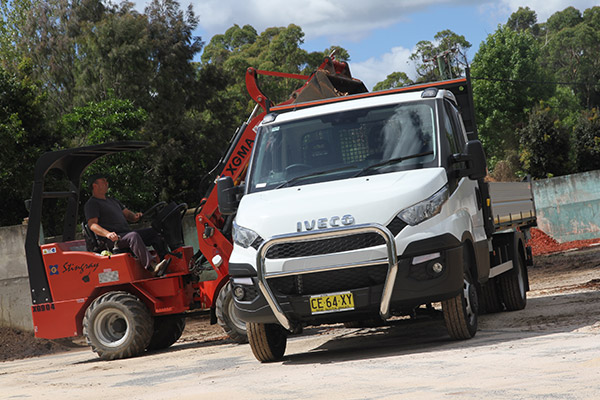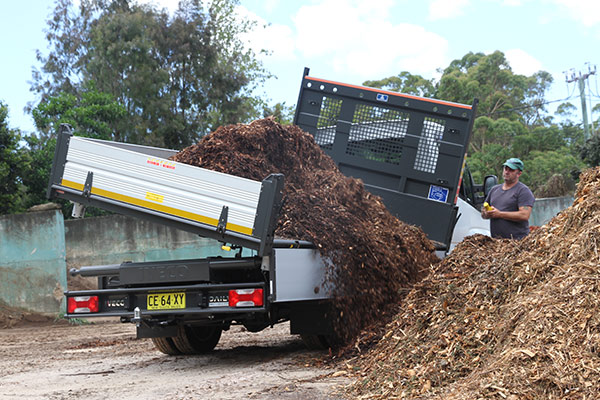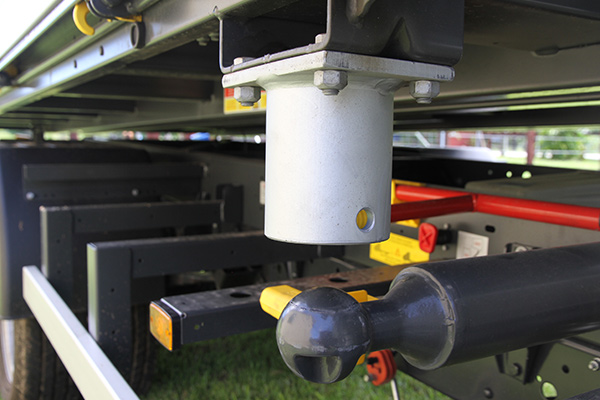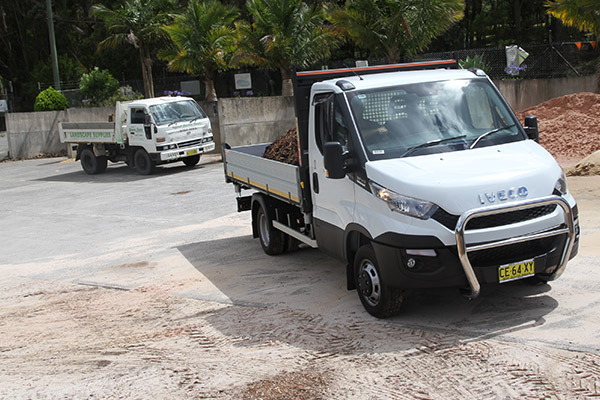With decades of Japanese durability dominating the light-duty tipper market, Iveco’s lunge with a Daily three-way tipper won’t be an easy haul. But as Steve Brooks reports, Iveco’s timing with this classy contender could be right on the money
For the most part, light-duty tippers contesting the Australian market share a number of historic, completely obvious and totally fundamental characteristics — that being Japanese heritage.
And as time and toil have proved with endless example, that heritage has crafted little tippers with extraordinarily rugged reliability and dour dependability, the likes of which have been rarely matched by any other models, in any other applications, at any other time.
To put it bluntly, little Japanese tippers with factory-fitted steel tipper bodies are as tough as teak and, on the surface at least, demonstrate that the demand for durability carries far more clout than random calls for greater comfort.
Yet to be just as blunt, these same tough little toilers can be also rough as guts.
Nothing, I’d suggest, rides as hard as a short Japanese tipper with no load in the back.
Even so, there’s nothing to suggest Japan Inc. will be changing anytime soon from the thick packs of short, stout steel springs that have battered and bounced, served and survived so well for so long.
Consequently, it stands to reason that with few competitive influences other than the mirror images of similarly specified kinsmen, the success and dominance of light-duty Japanese tippers continue to be absolute.
But for how long?
In this age of intense OH&S awareness, there’s the emerging attitude that ‘rough and tough’ need not be peas of the same pod.
Stepping into this formidable fray is Iveco’s smooth, sophisticated and exceptionally well appointed Daily with a factory-fitted three-way tipping body.
Sure, if Iveco’s hopes of putting a dent in Japanese dominance are to be even partially realised, toughness and durability will need to be established as inherent features of the Daily tipper.
However, those things will take time and work.
More immediately evident are the design and performance traits, which not only make the Daily an entirely new experience in light-duty tippers, but also further emphasise Iveco’s intention to push a European wedge into market segments where Japanese brands have a stranglehold on supremacy.
Obviously, it won’t be easy. But nor is it impossible.
There was a time, for example, when Japanese makes ruled the light-duty van business.
That changed dramatically about 20 years ago when Mercedes-Benz, spearheaded by its Vito and Sprinter models, paved the way for the continental collective to now hold a huge market presence, achieved almost entirely at the expense of the Japanese.
In fact, the light-duty van business is no longer predominantly a case of ‘Europe vs Japan,’ but rather a clash of continentals battling among themselves for market might.
With its versatile and extremely well-mannered Daily as the platform (incidentally, voted Europe’s 2015 Van of the Year), Iveco has engineered a two-pronged assault on the Japanese with fully imported tipper and tray models, effectively playing the Japanese at their own game.
It was, after all, the Japanese who decades ago first introduced light trucks with fully imported, factory-fitted tipper bodies and, more recently, road-ready ‘trade’ models equipped with well-designed tray bodies.
What Iveco adds to the mix, however, are levels of car-like comfort and convenience not normally associated with vehicles in this class.
On the new Daily tipper, the brand isn’t shy about stating its case: “Iveco is the only light commercial manufacturer offering a work-ready three-way tipping body …”
Engine and Transmission
Under the snout is a 3.0-litre diesel engine, boosted by a variable geometry turbocharger and intercooler to deliver peak power of 125kW (170hp) between 2900 and 3500rpm, and top torque of 430Nm (317ft-lb) from 1500 to 2600rpm.
Euro 5 emissions compliance is achieved with an exhaust gas recirculation (EGR) system, while for more fundamental functions like checking oil and water, the short snout provides good access.
There’s the choice of two transmissions — a six-speed overdrive manual or a super-slick eight-speed double overdrive auto.
Cab and Controls
As for actually driving the Daily, there’s plenty to like, not least an incredibly generous car-like interior environment boasting a superb array of standard comfort, safety and operational features.
The list is long, but to highlight just a few, there are: driver, passenger and curtain airbags; cruise control; electric windows; heated and electrically adjustable mirrors; auto climate control system; central locking; and an amazing amount of in-cab storage areas, including a cavernous space under the twin passenger seats which is capable of holding a good-sized Esky.
Additionally, the driver sits high on a heated suspension seat which provides good vision over the drooping snout.
Unfortunately though, the A-pillar on the driver’s side is surprisingly intrusive, particularly at roundabouts.
Payload and Tipper
The base for both tipper and tray versions is the Daily 50C17 cab-chassis, offered in wheelbases of 3.75m and 4.35m for tipper and tray models respectively.
The standard gross vehicle mass (GVM) for both versions is 4495kg, which allows each model to be driven on a car licence.
For holders of a truck licence there’s an optional GVM rating of 5200kg which, in the tipper’s case, boosts payload capacity from a nominal 1.5 tonne to around 2.2 tonne.
According to Iveco’s material, the tipping body is 3.7m long and 2.1m wide, with 400mm deep sideboards and tailgate, and a stout headboard providing protection for the back the cab.
By any measure, it is a generously proportioned body given the relatively modest payload capacity.
It also appears to be extremely well built and the finish quality on the steel body is first-rate.
According to Iveco, “Full steel construction using 1.8mm plate and corrosion inhibitor ensure durability, while the sub-frame is hot-dip galvanised and powder coated”.
Furthermore, “Sideboards and tailgate feature galvanised steel locks which are flush mounted when locked for improved safety”.
It’s also worth noting the fitment of multiple anchor points in the floor, which are easily lifted to use and just as easily fall flush into recesses when not in use.
Tie hooks are also tucked under the sideboards.
The standout feature, however, is the three-way tipping action. Iveco has designed a system that is both unique and easy, though it does demand a good deal of thought until familiarity sets in.
The key components of the three-way function are a six-stage hoist with a ball head, and stout round beams mounted across the front and rear of the chassis.
Fabricated into the end of each beam is a ball joint, and on the underside at each corner of the tipping body is a cup fitting which lowers onto the corresponding ball.
The tipping function — conventional rear tipping on either side — is determined by the placement of two locking pins which secure the cups to the ball.
For conventional rear tipping, the locking pins obviously secure the cups to the balls at the rear corners.
Conversely, to tip to the driver’s side, the cups are locked to the balls at the front and rear of that side.
Likewise, to tip to the passenger side, the cups are locked to balls at the front and rear of that side.
To provide a degree of safety against placing the locking pins in the wrong positions and potentially damaging the body or the hydraulic ram, Iveco has developed a couple of relatively simple safeguards.
The two locking pins have, for instance, different end diameters, meaning they can only be joined to those cups with a corresponding diameter, thus avoiding any risk of inadvertently tipping the headboard forward into the back of the cab.
Nor can the pins be placed in diagonally opposed corners at the front and rear.
A further safeguard is a sliding arm behind the front round beam which allows only one front cup to be locked onto a front ball at any time, again to avoid the risk of tipping forward.
If none of this sounds particularly clear, patient practice or, better still, someone like Steve Prior from Iveco Sydney explaining the system’s qualities and quirks will quickly lift the clouds of confusion.
The actual raising and lowering of the tipping body is done with a remote handpiece cradled behind the driver’s seat.
Quite simply, it couldn’t be any simpler.
What’s more, it can be used outside the cab or from the driver’s seat to spread the load.
We experimented with loads of sand and bark tipped over the rear and over each side, and while the hydraulic system’s ability to lift all loads quickly was impressive, side tipping a relatively small load of bark caused the lifting side to lean noticeably.
Sure, there was no suggestion that wheels were about to lose contact with the ground, but it was enough to raise questions about how stable the unit would be tipping, say, two tonnes of sand or gravel over the side.
To meet various unloading requirements, tailgate and sideboards can be released at the top or bottom hinges.
However, this leads to a word for the unwary.
As an attractive incentive, Iveco is currently offering its Daily tipper and tray models with $2500 worth of genuine accessories, including a polished alloy nudge bar, hood and headlamp protectors, floor mats and a 3.5 tonne tow bar kit.
It’s unquestionably a worthwhile package, but a problem arises when tipping over the rear with the tailgate hinged at the bottom.
As the tip angle increases, the bottom edge of the tailgate lines up perfectly with the tow coupling, and only millimetres remained before we noticed the pending contact which would’ve certainly damaged the tailgate.
The obvious alternative is to use the upper tailgate hinge or, if you’re not towing, take the tow coupling out.
Performance
The test unit supplied by Iveco Sydney was fitted with all the optional ‘fruit’, including the auto transmission and, loaded or unloaded, the combination of a highly responsive engine and supremely smooth auto shifter produced a performance equally at ease in suburban snarls or freeway flings.
It’s also worth mentioning that whereas the manual version runs a 3.9:1 rear axle ratio, the auto uses a taller 3.6:1 ratio.
Coupled to the auto’s 0.667:1 top gear, it makes for a little truck with very long legs on the open road.
At the other end of the performance perspective, braking is brilliant through big discs front and rear enhanced by the standard inclusion of ABS anti-lock, ASR anti-skid with electronic brake-force distribution, and the highly worthwhile ‘hill hold’ function.
Effortless power steering and an extremely tight turning circle give the Daily all the right attributes for sliding easily into tight spaces, but at highway speeds the steering might be a tad too twitchy for some tastes.
As for ride quality, it’s superb.
Verdict
Empty or loaded, on any road, independent suspension front and rear on axles rated at 2.1 tonne and 3.7 tonne respectively deliver an outstanding passage.
That, in a bucket-sized nutshell, sums up the Iveco Daily three-way tipper.
According to our sources, it carries recommended retail prices of around $65,950 for the manual model and $69,950 for the auto, complete with up to $2500 worth of accessories.
Is it good value for money? Certainly seems so.
Does it have the ability to put a dent in Japanese domination? Time will tell.
Is it worth considering? Absolutely.
Specifications
Make/Model: Iveco Daily 50C17 with 3-way tipping body
Engine: Iveco 3.0-litre direct injection diesel with variable geometry turbocharger and intercooler. Euro 5 emissions compliance
Power: 125kW (170hp) at 2900 to 3500rpm
Torque: 430Nm (317ft-lb) at 1500 to 2600rpm
Transmission: ZF 8-speed (double overdrive) torque converter automatic. Manual 6-speed also available
Suspension: Front and rear – independent with adjustable steel torsion bar
Brakes: Front and rear — 290mm diameter discs with ABS anti-lock, ASR anti-skid, electronic brake force distribution and hill-hold function
Payload: 1500 to 2200kg
GVM: 4495 to 5200kg














